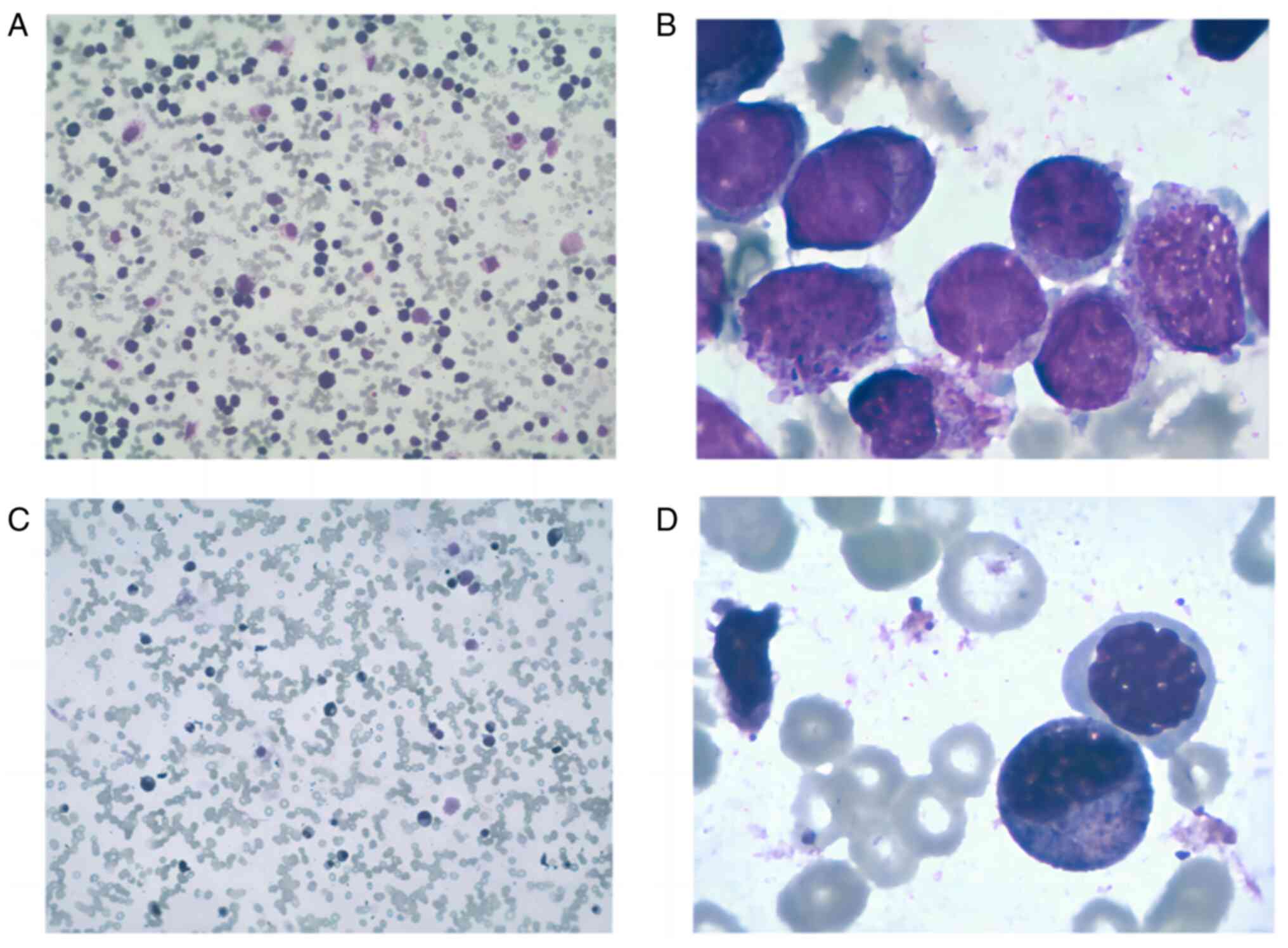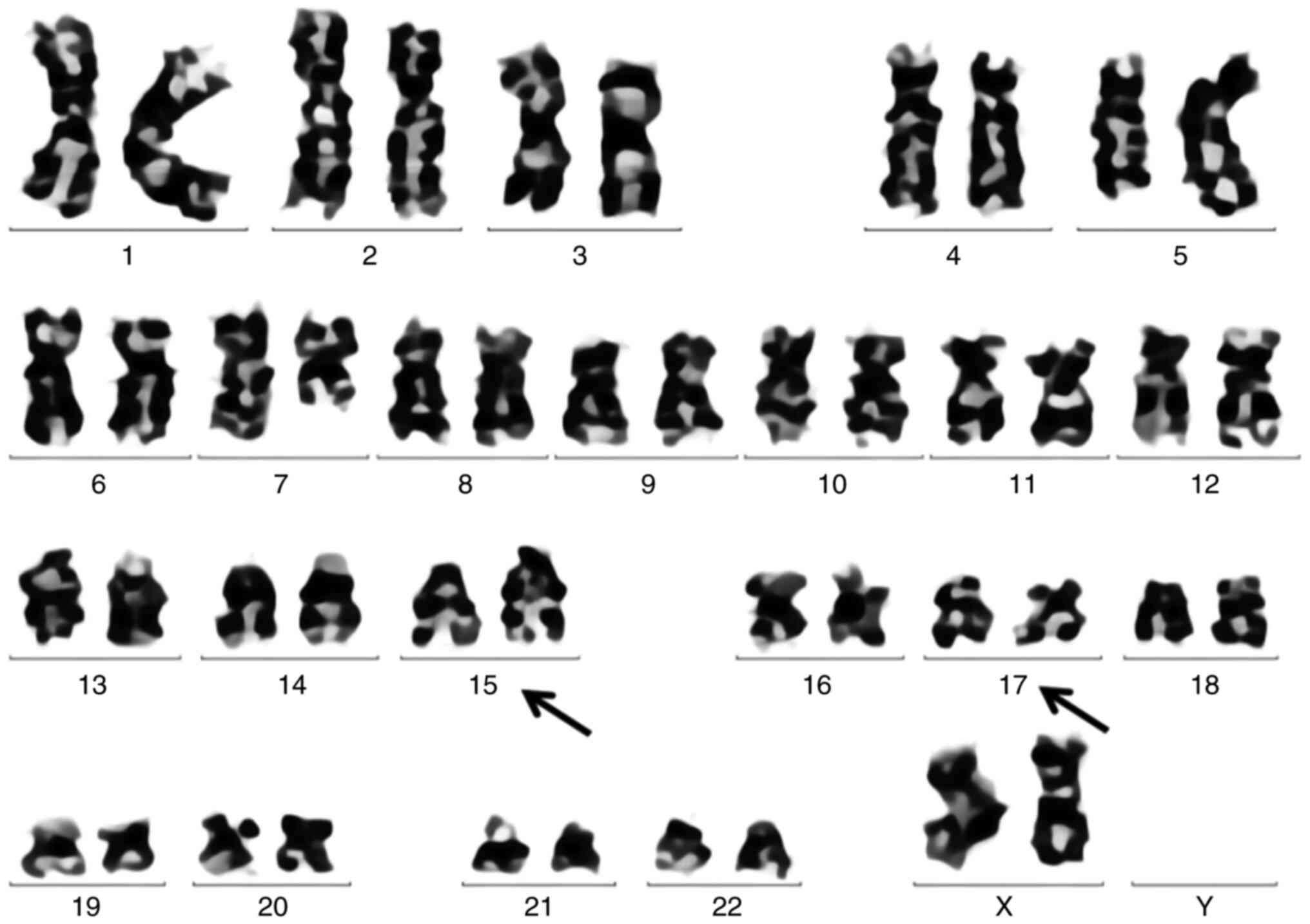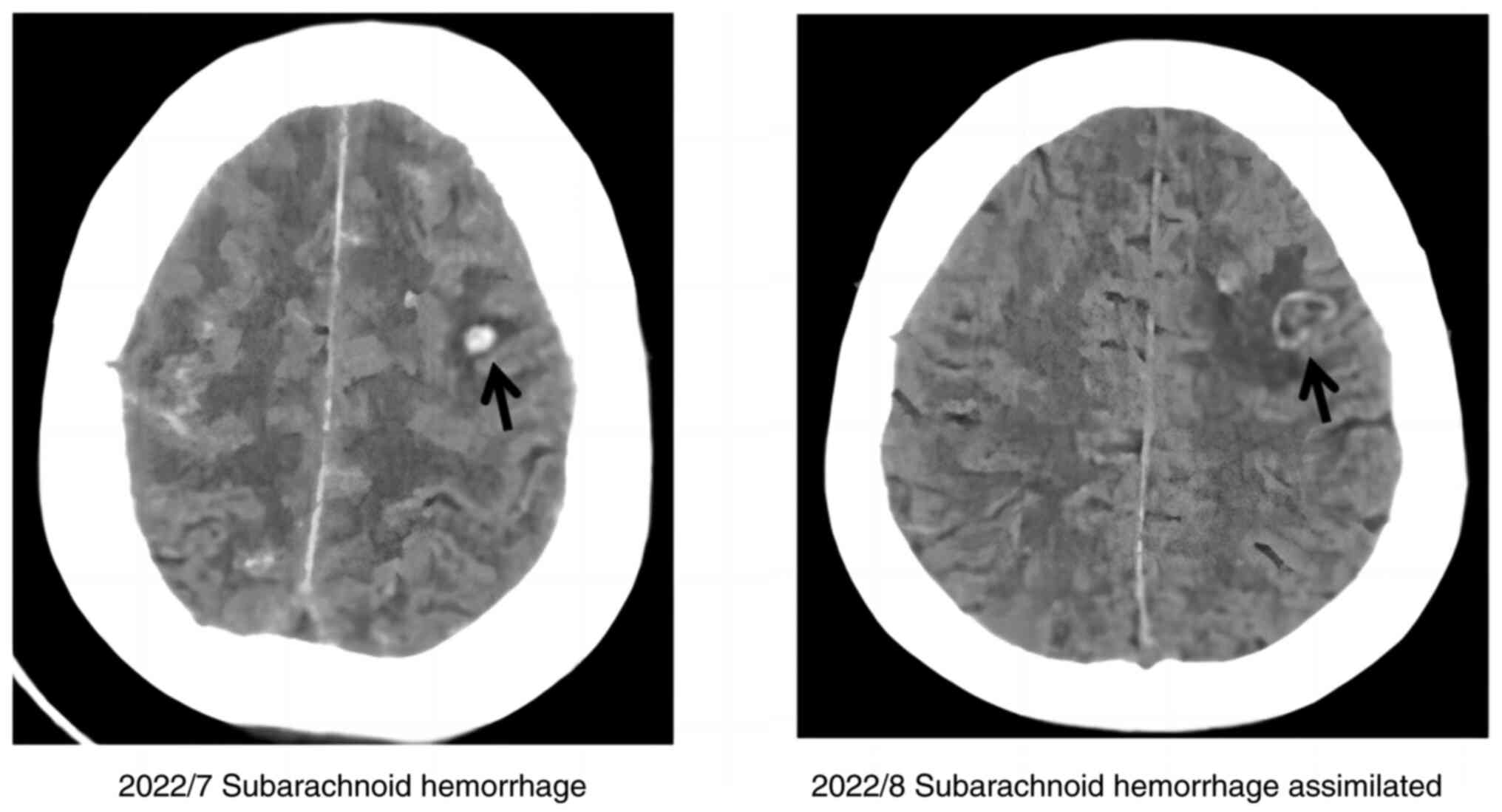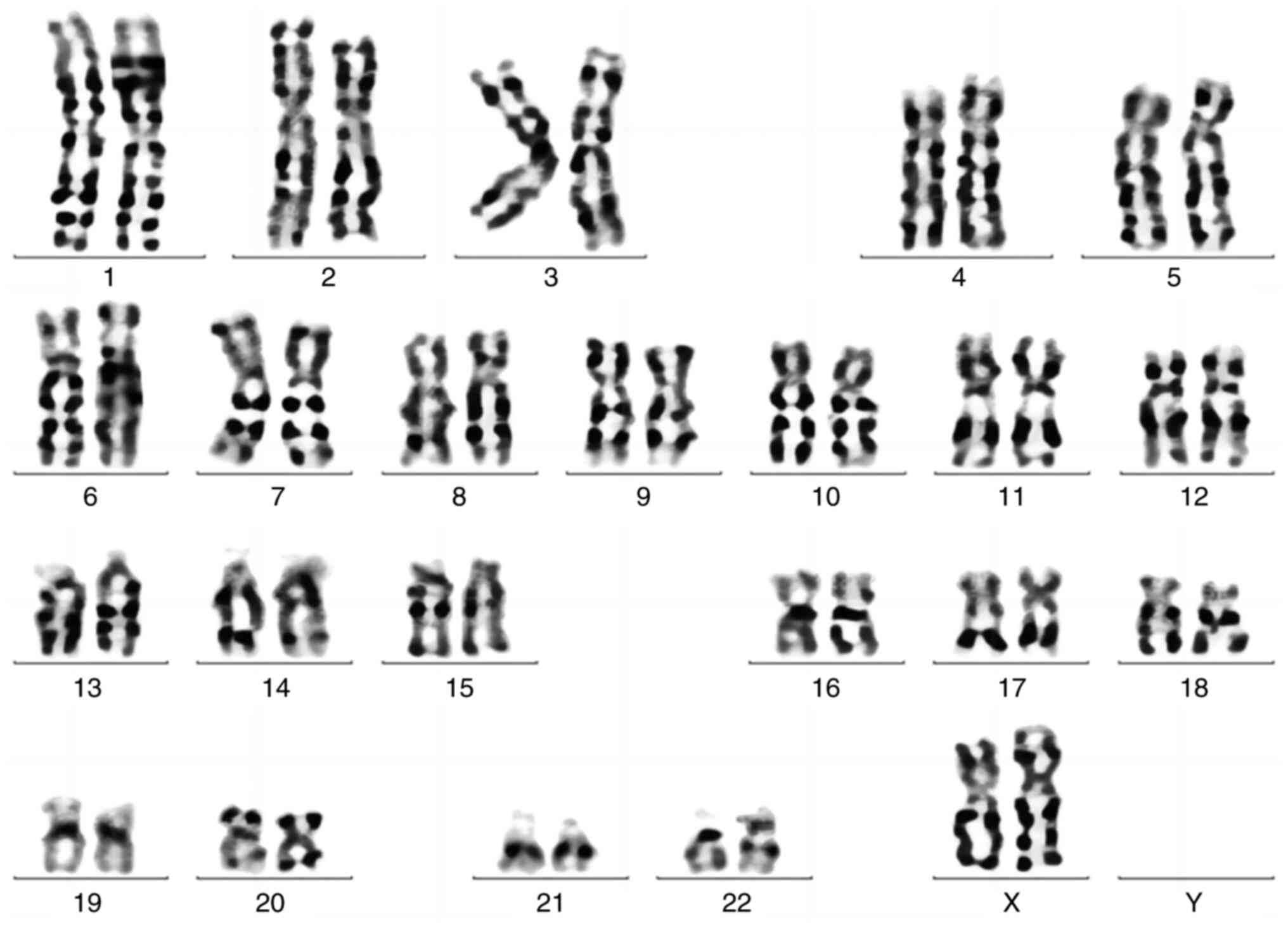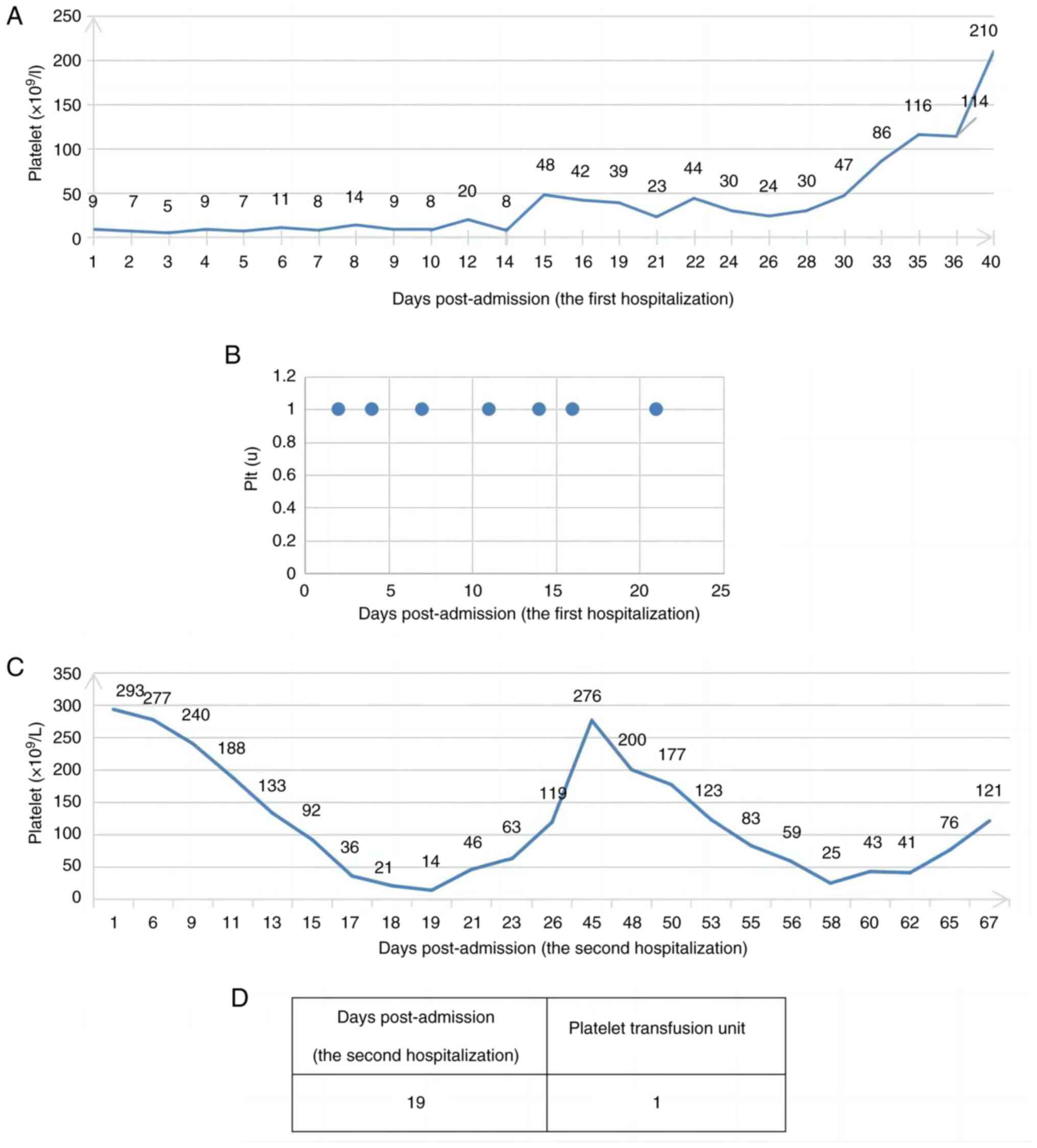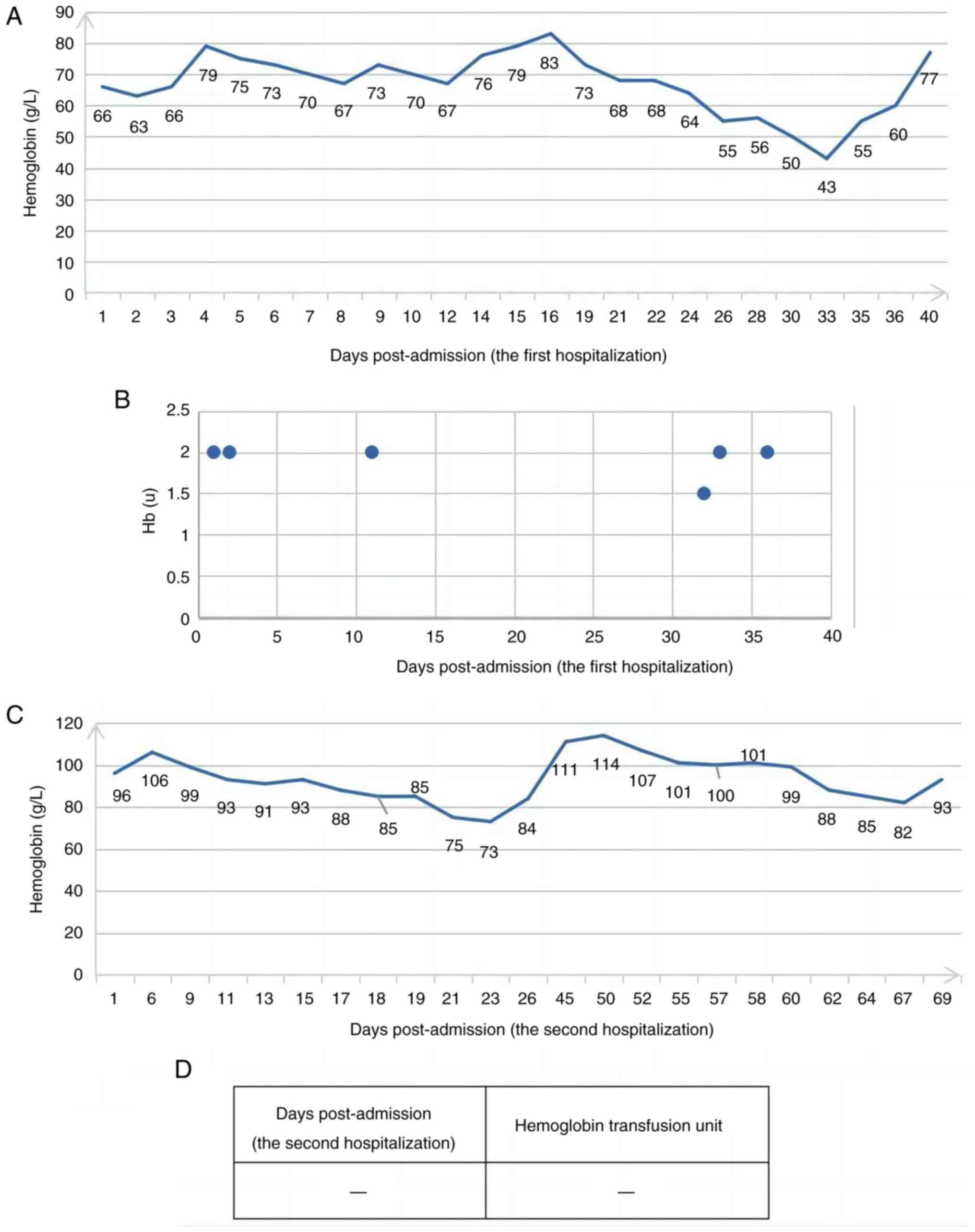Acute promyelocytic leukemia with additional chromosome abnormalities in a patient positive for HIV: A case report and literature review
- Authors:
- Published online on: April 19, 2024 https://doi.org/10.3892/ol.2024.14407
- Article Number: 274
-
Copyright: © Li et al. This is an open access article distributed under the terms of Creative Commons Attribution License.
Abstract
Introduction
HIV attacks the human immune system and targets CD4+T lymphocytes, which are important immune cells. The introduction of highly active antiretroviral therapy (HAART) has markedly improved outcomes in patients with HIV infection and long-term survival can be expected even following the onset of acquired immune deficiency syndrome (1). However, patients with HIV are at increased risk of cancer due to oncogenic factors, including the immune dysregulated state, direct pathogenicity of the virus, chronic stimulation and prolonged drug exposure (2). Acute promyelocytic leukemia (APL), the French-American-Britain classification of acute myeloid leukemia (AML)-M3 (3), is distinct among AML subtypes due to its unique prognosis and pathogenesis. The malignant clone is characterized by a specific translocation t(15;17), which results in rearrangement the retinoic acid receptor α (RARα) genes and promyelocytic leukemia (PML) (4). The resulting protein product interferes with maturation of the immature myeloid morphology (5). APL is now a highly curable disease with an overall response rate of 95% and current cure rate is >80% (5). The incidence of HIV with APL is extremely rare, with only 12 cases reported to date, and it is even rarer in the chromosomally complex APL population. Due to the small number of cases, there is no uniform standard of treatment for APL complicated with HIV, and the prognosis remains unclear (2,4,6–14). The status of patients infected with HIV and initiation and course of chemotherapy are increasingly a cause of concern due to the highly effective HAART and its success in controlling viral load (6,7). The present report describes a case of high-risk APL with additional chromosomal abnormalities and HIV infection and discusses the existing literature on this unique population.
Case report
A 49-year-old previously healthy female patient presented in July 2022 following abdominal pain for 1 week and intermittent mild fever combined with fatigue for 3 days. Before admission to The First Affiliated Hospital of Jishou University (Jishou, China), the patient was admitted to Fenghuang County People's Hospital (Fenghuang, China) at which the initial hematological assessment determined the following: An elevated white blood cell (WBC) count of 40.97×109/l (normal range, 4.0–10.0×109/l); neutrophil count, 4.30×109/l (normal range, 1.8–6.3×109/l); platelet count of 14×109/l (normal range, 100–400×109/l) and a hemoglobin, 75 g/l (normal range, 110–150 g/l) (15). Whole abdominal computed tomography (CT) scan (KVP:120, MA:177, SL-573.5MM, TITLE:0, Head 5.0, Hr40 3) and abdominal standing films showed no abnormalities. Intravenous cephalosporin antibiotic administration (2 g ceftazidim twice/day for 4 days) and fluid replacement were used to control the fever but the efficacy was limited. Subsequently, the patient was admitted to the Emergency Department of The First Affiliated Hospital of Jishou University for further diagnosis and treatment in July 2022.
Physical examination revealed an afebrile case with conjunctival pallor and abdominal tenderness without tonsillar exudates. Old ecchymosis was visible on the skin without fresh petechiae and ecchymoses. There was no hepatosplenomegaly or lymphadenopathy. Physical examination of the heart and lungs showed no positive signs. The patient had no history of tobacco, alcohol or illicit drug use.
Laboratory assessment demonstrated the following: Hemoglobin, 66 g/l; total leukocyte count, 41.86×109/l; platelet count of 9×109/l and reticulocyte count of 32.3×109/l. Blood tests showed differential leukocyte counts were as follows: 19.8% neutrophils, 12.9% lymphocytes and 66.5% monocytes (Table I). Immature cells and rod-shaped bodies were visible but no schistocytes were observed in the peripheral blood smear. Prothrombin time and activated partial thromboplastin time were 17.4 and 41.6 sec, respectively. Fibrinogen levels were 1.294 g/l, D-dimer levels were 23.97 µg/ml and fibrin monomer concentration was 40.05 µg/ml. Serum potassium levels were 2.79 mmol/l and lactate dehydrogenase concentration was 808 U/l. Serum electrolytes, calcium, magnesium, urea and creatinine were within normal range. Liver function tests were normal. Hepatitis B surface antigen index was 2362.00 and the HIV antibody index was 1303.00. The hepatitis B virus (HBV) titer was 2.96×103 IU/ml, as evidenced by HBV-DNA virus nucleic acid quantitative detection-internal standard quantification (High Pure Viral Nucleic Acid kit, Roche Diagnostics, Mannhein, Germany). The lymphocyte subsets [analyzed by flow cytometry (MoFlo® Astrios; Beckman Coulter) (16)] were as follows: Lymphocytes, 4.01%; B lymphocytes, 22.99%; helper/induced T lymphocytes, 21.30%; CD4/CD8, 0.55% and absolute helper/induced T lymphocytes count, 335.00/µl.
Based on morphology (cells from the bone marrow aspirate smears stained with Wright's stain for 10–15 min and myeloperoxidase respectively. For myeloperoxidase staining: 10–15 drops of 0.3% benzidine ethanol solution in the slices, after 1 min, 10–15 drops of hydrogen peroxide solution were added for 5 min. Slides were rinsed and Wright's stain was added for 30 min, followed by another rinse. Images were captured using an optical microscope at magnifications, ×10 and ×100) (Fig. 1), 92% of marrow cells were promyelocytes [myeloperoxidase (MPO+++)]. These variant (monocytoid) promyelocytes expressed CD13, CD33, cMPO and human leukocyte antigen-DR, whilst CD34 and CD19 were absent. Monocytic markers were either absent (CD14) or scarcely expressed (CD64). Cytogenetic analysis revealed an abnormal female karyotype [46, XX, add(5)(q15), add(5)(q31), add(7)(q11.2), add(12)(p13), t(15;17)(q24; q21)[19]/46, XX; Fig. 2], whilst myeloid leukemia fusion gene results were negative for AML1/ETO, mixed-lineage leukemia and core-binding factor subunit β rearrangements. For fusion gene detection, leukemia-associated fusion gene analysis detected positive expression of PML-RARα, and negative expression of BCR/ABL1, MLL/ELL, MLL/SEPT6, SET/CAN, TEL/PDGFRB, TLS/ERG, MLL/AF6, NPM1/RARα, TEL/ABL1, AML1/ETO, CBFβ/MYH11, PLZF/RARα, FIP1L1/PDGFRA, DEK/CAN, AML1-MDS1/EVI1, AML1/MTG16, AML1/EAP, NPM1/MLF, MLL/AF9, MLL/AF10, MLL/ENL, MLL/AF17, MLL/AF1q, MLL/AF1p (Total RNA was extracted from the patient's bone marrow mononuclear cells by TRIzol method. The reaction solution was prepared according to the instructions of leukemia fusion gene detection kit, and the amplification reaction was performed by ABI7500 amplification instrument). For the mutated gene fraction, sample transfer/genomic DNA levels were detected by deep target sequencing (Next-generation sequencing; NGS). Gene mutations in AML suggested the following: Calreticulin (CALR) p.E371fs, variant abundance, 2.40%) and lysine methyltransferase 2C (KMT2C) p.H1826R, variant abundance, 49.30%. NGS was performed by Golddomain Medicine/Guangzhou Jinyu Inspection using DNA extracted from bone marrow mononuclear cells of the patient Using illumina platform NextSeq550 sequencing platform (Thermo Fisher Scientific, Inc.), 72 genes (ANKRD26, ABCB1, ARID1A, ARID1B, ARID2, ASXL1, ASXL2, ATG2B, BCOR, BCORL1, BRAF, CALR, CBL, CEBPA, CREBBP, CSF3R, CTCF, DDX41, DIS3, DNMT3A, ETNK1, ETV6, EZH2, FLT3, GATA1, GATA2, GFI1, GNB1, GSKIP, HRAS, IDH1 IDH2 IKZF1 JAK1 JAK2 JAK3 KDM6A KIT KMT2A KMT2C KRAS MPL MYC NBN NF1 NPM1 NRAS NTRK1 PHF6 PML PPM1D PTPN11 RAD21 RARA RUNX1 SBDS SETBP1 SETD2 SF3B1 SMC1A SMC3 SRSF2 STAG2 STAT5A TERC TERT TET1 TET2 TP53 U2AF1 WT1 ZRSR2) of patients were deeply sequenced by targeted amplicon method (NGS amplicon sequencing primers were designed and synthesized by Thermo Fisher company). Sequencing depth of 170-fold.] Reverse transcription (RT)-qPCR testing was positive for the PML/RARα translocation [Type L; PML-retinoic acid receptor α (RARα) gene copy number, 15,006 copies; ABL1 gene copy number, 138499 copies; PML-RARα/ABL1:10.835%; The relative quantitation of PML/RARa=(copiesPML/RARa/copiesABL) ×100% (17)]. PML-RARα mRNA expression was measured using RT-qPCR [The patient's bone marrow RNA was reverse-transcribed onto the cDNA and tested for PML/RAR α transcripts with primers: forward, 5′-GCAATTTAGGTATGAAAGCCAGC-3′, and reverse, 5′-CTTTCAGCATTTTGACGGCAACC-3′; and fluorescein amidite-labeled probe (Boshang Biotechnology Co., Ltd.): 5′-CTGCTCTGGGTCTCAATGGCTGCCTCC-3′; ABL was used as the reference gene and detected with the primers: forward, 5′-TCCATCTCGCTGAGATACGAAG-3′, and reverse, 5′-ATGATGAACCAACTCGGCCA-3′; and VIC-labeled probe 5′CAACACTGCTTCTGATGGCAAGCTCTACG3′. RT-qPCR was tested for 2 min at 50°C, pre-denatured for 3 min at 95°C, and then 40 cycles of denatured for 5 sec at 95°C, annealed and extended for 30 sec at 58°C were performed using the ABI 7500 Real-time PCR system. Data was collected and analyzed using ABI 7500 software v2.3 (Thermo Fisher Scientific, Inc.)].
Chest CT and electrocardiography were normal. Multigated equilibrium radionucleotide cineangiography revealed normal cardiac wall motion and ejection fraction of 58%. However, cranial CT suggested a subarachnoid hemorrhage (Fig. 3).
Remission was induced using all-trans-retinoic acid (ATRA; 25 mg/m2). The patient was administered Pirarubicin hydrochloride (45 mg/m2) via a continuous intravenous infusion over 24 h (20 mg for 3 day, 10 mg × 2 day) and arsenic trioxide (ATO; 0.16 mg/m2) as an intravenous bolus once daily for three days. As the corrected QT interval of the patient increased from normal to 492 msec, ATO was intermittently used during induction. The patient developed differentiation syndrome during chemotherapy but it did not recur following ATRA dose reduction (20 mg twice/day). In the absence of disseminated intravascular coagulation, heparin was not administered. Red cells, platelets, fibrinogen and cryoprecipitate were transfused as required.
Following discussion with the Department of Infection, HAART was initiated during the induction. HAART regimen comprised efavirenz (600 mg daily) and lamivudine (300 mg daily). Simultaneously, the patient received anti-HBV therapy (tenofovir disoproxil fumarate, 300 mg daily) due to infection with hepatitis B. A total of 4 weeks later, the CD4+ T cell count was decreased, whilst the HIV-1 titer was below the normal range of detection values.
Following one cycle of chemotherapy, the patient was in complete morphological remission (CMR; Fig. 1C and D). Subsequently, the patient was administered one cycle of consolidation chemotherapy with idarubicin (IDA; 8 mg/sqm/d; days 1–3; bolus intravenous injection) and cytosine arabinoside (1 g/sqm/12 h; days 1–3, continuous intravenous infusion), and HAART was administered throughout. The chromosome karyotype of the patients was normalized after chemotherapy. As of January 2024 (Fig. 4), the patient is receiving regular chemotherapy, but is asymptomatic and has tolerated both chemotherapy and HAART well; however, there is risk of recurrence and need further observation
Discussion
HIV attacks the human immune system and may increase risk of malignant tumors, which may be associated with oncogenic factors, including immune dysregulation status, direct viral pathogenicity, chronic stimulation and long-term medication exposure. An association between HIV infection and several types of malignancy has been reported (1). Although the most frequent neoplasms are non-Hodgkin lymphoma, Kaposi sarcoma and invasive cervical carcinoma, other cancers are increasingly reported (2,18). A few cases of AML have been described in patients with AML and HIV infection (9,10). As the incidence of APL in patients infected with HIV is sporadic, the therapeutic approach is individualized and often challenging (2,4,8). Recently, with the advent of novel therapies, survival of patients with HIV and APL has improved but there are no relevant guidelines for treatment of the concomitant HIV and APL (6,7,9–14). Therefore, evaluating the mechanism and clinical characteristics of these cases is important. The present report described a case of an HIV-positive patient with a high-risk AML M3L presenting with hyperleukocytosis complicated by hematencephalon and prolonged QT interval during induction therapy. HIV may also infect monocytes and macrophages in addition to functioning as a tropic retrovirus and neurotropic virus for helper inducer (CD4) lymphocytes (19). This increases DNA-binding activity of the NF-κB transcription factor, which can further activate genes that may be involved in leukemogenesis [for example, IL-6, granulocyte-colony stimulating factor (CSF) or granulocyte-macrophage-CSF] through paracrine or autocrine loops (8). Immunodeficiency may also explain. The high incidence of APL in two disorders associated with chronic T cell abnormality, severe combined immunodeficiency and Wiskott Aldrich syndrome, suggests that an immunodeficient state is associated with APL (2,20). Furthermore, during HIV infection, tumor cells evade immune surveillance via lost or decreased immune response. The development of APL in patients infected with HIV may involve the potent transactivator protein Tat, which serves a crucial role in angiogenesis and can replace the preformed basic fibroblast growth factor (bFGF). bFGF increases myelopoiesis directly via FGF receptors on myeloid progenitors (21). HIV may also alter the bone marrow microenvironment to make it more favorable for proliferation of leukemic cells (19,21). Lastly, in the era of ART, the improvement in survival rate following HIV infection has led to an increase in long-term morbidity, including APL. Exposure to drugs, including cell inhibitors, HIV nucleoside analogs, benzene, alkanes and cytotoxic molecules, can increase the risk of leukemia complications in patients with HIV. In addition to the aforementioned factors, ionizing radiation can cause chromosome breakage and recombination, along with alterations and mutations in the c-myc and ras genes, which serve an important role in inducing leukemia. The greater the radiation dose, the higher the risk of leukemia. It is hypothesized that the occurrence of APL in HIV may be coincidental but certain authors suggest that incidence of APL is higher in HIV-infected patients (22). Cytopenia of patients with HIV infection is usually attributed to action of viruses and antiviral drugs, and the accompanying malignant tumors of the hematopoietic system are often ignored (23). Therefore, further assessment and monitoring of potential associations is needed to determine the cause of concomitant HIV and APL. Although prognostic variables have been assessed to stratify patients, the data concerning the prognostic relevance of CK are conflicting (24–29). Most patients with APL who have t(15;17) chromosome heterotopia are considered to have a good prognosis, but certain factors affect prognosis including high WBC count, the male sex, elevated serum creatinine levels, advanced age and fibrinogen levels (30). The prognosis of complex chromosome karyotype in patients with AML but no HIV is poor but whether CK affects the prognosis of patients with APL is debatable and, to the best of our knowledge, few studies have assessed this (25,31). The additional chromosome abnormality does not affect overall survival (OS). Moreover, the additional chromosome abnormality population has advantages in duration of complete remission (CR) and event-free survival rate (EFS) (25–26). Wiernik et al (25), through uni- and multivariate survival analysis, reported that treatment regimen with arsenic acid could prolong the disease-free survival of patients with APL and improve prognoses. Arsenic acid and retinoic acid may have a synergistic effect on clearing promyelocytic leukemia clones, thus improving the curative effect (32). Wan et al (27) reported that the additional chromosome does not affect the OS rate but patients with APL carrying additional chromosome abnormalities have delayed recurrence, which may be related to the lack of a serine proline enrichment region in PML-RARα fusion gene S (33). However, Vu et al (28) reported that patients with additional chromosomal abnormalities have aggressive disease, and additional chromosomal abnormalities are independent adverse prognostic factors for these patients. Another study (29) demonstrated inferior EFS for patients harboring complex karyotypes but not for patients harboring additional cytogenetic abnormalities. In conclusion, prognosis of patients with APL with additional chromosomes remains controversial and needs more evidence. At the molecular level, mutations were detected in CALR (p.E371fs) and KMT2C genes in the present patient. CALR is a multifunctional protein with 417 amino acids and is mainly localized in the luminal of the endoplasmic reticulum (34). A study reported that gene expression of CALR is downregulated in patients with APL (35). Another study reported that CALR may participate in clearance of tumor cells by reducing angiogenesis and immune system activation (36). Moreover, increased CALR expression may cause tumor metastasis, which may be associated with lack of matrix attachment or regulation of Ca2+ signaling (37). In the nucleus, CALR inhibits the interaction between the retinoic acid receptor and its DNA response elements and CALR silencing causes a significant decrease in both erythroid and MK differentiation of human HSPC (38). KMT2C is an epigenetic modifier gene that participates in histone methylation and affects transcriptional coactivation of gene expression. KMT2C is expressed in several types of tumor tissues, including leukemia, and is among the most frequently mutated genes in human cancer (39). KMT2C is a haploinsufficient tumor suppressor (40) and its inhibition impairs the differentiation of hematopoietic stem cells and progenitor cells. In a study on AML with fms-related receptor tyrosine kinase 3 (FLT3)-internal tandem duplication (ITD) mutations, RFS and OS were markedly decreased in patients with recurrent KMT2C mutations and deletions compared with patients with FLT3-ITD mutations without KMT2C (41). To the best of our knowledge, however, there are no reports of CALR or KMT2C mutations or CK with HIV and more studies are needed to reveal their relevance.
APL is among the highly curable hematological neoplastic diseases with a 10-year OS rate of 93.9% owing to the use of ATRA and ATO (42). A total of 13 cases of APL with HIV have been reported (Tables II and III) (2,4,6–14). Of these, treatment and survival details are unavailable for one case (9). ATRA was used in 12 patients and 10/12 (83.3%) evaluable patients remained in CR at the time of reporting, which is similar to the experience with classic APL (32). For the 13 patients, the median age was 37 years (range, 22–67 years); 9 were male (69.2%) and 4 (30.8%) were female. A total of four cases were in the high-risk and 9 in the low-median group (based on NCCN guidelines) (43). The patients in the high-risk and the low-median group who were still in the CR status at the time of reporting accounted for 50.0 and 88.9%, respectively. The treatment failed for one patient as ATRA was used inappropriately (CR was not maintained for a long period after chemotherapy). A total of 6/12 (50.0%) patients who received chemotherapy-alone were alive during CR at a median follow-up of 10 months, which is consistent with classical APL treated with chemotherapy-alone (44). Thus, even from a small number of cases, it appears that there is no difference in survival between individuals with HIV. However, extensive data are needed to confirm this observation. Therefore, chemotherapy should not be rejected even for patients with HIV. Despite therapeutic advances, early mortality of APL is 32.6–34.6% (45). Hemorrhage remains one of the most common causes of early mortality (46) and mainly occurs in the brain and lungs. High WBC count and prolonged Prothrombin time predict severe bleeding in patients with high-risk APL (47,48). Strategies to reduce early death are key for improving the survival of patients with APL (42). To prevent early death, patients with high risk of early death and hemorrhage should be identified. The patient in the present report suffered from a subarachnoid hemorrhage after diagnosis. Platelet transfusion was administered during induction chemotherapy but the efficacy was not obvious, which may be associated with heavy tumor burden and the immune dysfunction caused by HIV. Platelet transfusion resistance (PTR) refers to persistently inadequate increments in post-transfusion platelet count. It is commonly defined as a corrected count increment of the platelet count <7.5×109/l or a % platelet recovery of <30% within 60 min post-transfusion. PTR can result from non-immune and immune factors; non-immune causes are more common. These factors include infection, disseminated intravascular coagulation, fever (body temperature ≥38°C), bleeding, heparin administration, splenomegaly and intravenous antibiotic use. Immune factors include incompatibility of non-specific antigens, such as human leukocyte antigen class I, ABO, CD36 and human platelet antigen (48,49). Following one cycle of induction chemotherapy and HAART, re-examination of the bone marrow morphology of the patient in the present report revealed CR, effective platelet transfusion and a notably decreased transfusion volume of platelets (Fig. 5), which further confirms that the poor efficacy of platelet transfusion may be related to the high tumor burden. Simultaneously, red blood cell infusion was markedly decreased compared with before (Fig. 6). However, prolonging QT interval is common, especially in frail patients, and attention should be paid to the risk to their heart (50). The patient in the present report experienced repeated prolonging of QT interval during the induction of chemotherapy, during which potassium supplementation and electrocardiogram monitoring were performed, while arsenic treatment was intermittent. The patient in the present report had HIV and APL, and received treatment that is considered to be ‘standard of care’. Standard treatment for APL together with HAART should be used in patients with HIV infection when possible. Attempting to prolong the maintenance treatment cycle may overcome the adverse effects of complex karyotype on relapse-free survival but needs further clinical research. The disease state of patients with APL with complex chromosome karyotype needs to be monitored to identify early recurrence and ultimately improve their prognoses. It is difficult to establish a definite association between HIV and APL due to the scarcity of cases. Multicenter clinical studies are needed to define epidemiology, standardize cytogenetic/molecular features and improve therapeutic management.
Table II.Previous cases of acute promyelocytic leukemia with human immunodeficiency virus infection. |
Acknowledgements
Not applicable.
Funding
The present study was supported by the Innovation Platform and talent program of Hunan Province (grant no. 2021SK4050) and the Natural Science Foundation of Hunan Province (grant no. 2023JJ30609).
Availability of data and materials
The data generated in the present study are included in the figures and/or tables of this article.
Authors' contributions
KS and XL conceived and designed the study. XL and ML collected all relevant data of patients and drafted the manuscript. LW coordinated the clinical management. JT and ZS analyzed the data. KS revised the manuscript. KS and XL confirm the authenticity of all the raw data. All authors have read and approved the final manuscript.
Ethics approval and consent to participate
Not applicable.
Patient consent for publication
Written consent for publication of the case report and any accompanying images, without any potentially identifying information, was provided by the patient.
Competing interests
The authors declare that they have no competing interests.
References
|
Palella FJ Jr, Delaney KM, Moorman AC, Loveless MO, Fuhrer J, Satten GA, Aschman DJ and Holmberg SD: Declining morbidity and mortality among patients with advanced human immunodeficiency virus infection. HIV Outpatient Study Investigators. N Engl J Med. 338:853–860. 1998. View Article : Google Scholar : PubMed/NCBI | |
|
Kunitomi A, Hasegawa Y, Lmamura J, Yokomaku Y, Tokunaga T, Miyata Y, Iida H and Nagai H: Acute promyelocytic leukemia and HIV: Case reports and a review of the literature. Intern Med. 58:2387–2391. 2019. View Article : Google Scholar : PubMed/NCBI | |
|
Gupta V, Shariff M, Bajwa R, Patel I, Ayyad HA, Levitt MJ, Mencel PJ and Hossain MA: Acute myeloid leukemia acquiring promyelocytic leukemia-retinoic acid receptor alpha at relapse. World J Oncol. 10:153–156. 2019. View Article : Google Scholar : PubMed/NCBI | |
|
Mahmoud A, Ghrewati M, Kania B, Naseer M, Kapoor A and Michael P: Aleukemic acute promyelocytic leukemia: How Concomitant HIV, Hepatitis C, and chronic alcohol use disorder may have hidden an underlying malignancy. Am J Case Rep. 24:e9380862023. View Article : Google Scholar : PubMed/NCBI | |
|
Korsos V and Miller WH Jr: How retinoic acid and arsenic transformed acute promyelocytic leukemia therapy. J Mol Endocrinol. 69:T69–T83. 2022. View Article : Google Scholar : PubMed/NCBI | |
|
Drilon AD, Gamboa EO, Koolaee R and Goel A: Acute promyelocytic leukemia in HIV-infected adults: A case report and review of therapeutic considerations. Clin Lymphoma Myeloma Leuk. 10:E47–E52. 2010. View Article : Google Scholar : PubMed/NCBI | |
|
Mendes-de-Almeida DP, Fernandez TS, Lovatel VL, da Rocha MM, Gomes BE, Monte-Mór BCR, Vianna DT, Alcoforado MTG, Kronemberg JMPB, Cardoso JPSC, et al: Acute promyelocytic leukemia in a long-standing HIV-positive patient: Case report and literature review. Leuk Res Rep. 18:1003392022.PubMed/NCBI | |
|
Calvo R, Ribera JM, Battle M, Sancho JM, Granada I, Flores A, Millá F and Feliu E: Acute promyelocytic leukemia in a HIV seropositive patient. Leuk Lymphoma. 26:621–624. 1997. View Article : Google Scholar : PubMed/NCBI | |
|
Gatphoh ED, Zamzachin G, Devi SB and Punyabati P: AIDS related malignant disease at regional institute of medical sciences. Indian J Pathol Microbiol. 44:1–4. 2001.PubMed/NCBI | |
|
Sutton L, Guénel P, Tanguy ML, Rio B, Dhedin N, Casassus P and Lortholary O; French Study Group on Acute Myeloid Leukaemia in HIV–Infected Patients, : Acute myeloid leukaemia in human immunodeficiency virus-infected adults: Epidemiology, treatment feasibility and outcome. Br J Haematol. 112:900–908. 2001. View Article : Google Scholar : PubMed/NCBI | |
|
Kudva GC, Maliekel K, Richart JM, Batanian JR, Grosso LE, Sokol-Anderson M and Petruska PJ: Acute promyelocytic leukemia and HIV-1 infection: Case report and review of the literature. Am J Hematol. 77:287–290. 2004. View Article : Google Scholar : PubMed/NCBI | |
|
De Vita S, De Matteis S, Laurenti L, Sorà F, Tarnani M, Cingolani A and Sica S: Acute promyelocytic leukemia in an HIV-infected patient: A case report. Am J Hematol. 81:3002006. View Article : Google Scholar : PubMed/NCBI | |
|
Boban A, Radman I, Zadro R, Dubravcic K, Maretic T, Civljak R, Lisic M and Begovac J: Acute promyelocytic leukemia after whole brain irradiation of primary brain lymphoma in an HIV-infected patient. Eur J Med Res. 14:42–43. 2009. View Article : Google Scholar : PubMed/NCBI | |
|
Malik A and Levine RL: The First Case Report of APL (Acute Promyelocytic Leukemia) in An HIV Positive Patient On (Highly Active Antiretroviral Therapy) Treated with Arsenic Trioxide. Blood. 114:41662009. View Article : Google Scholar | |
|
Wu P, Sun W and Li J: Rheumatoid arthritis patients with peripheral blood cell reduction should be evaluated for latent Felty syndrome: A case report. Medicine (Baltimore). 99:e236082020. View Article : Google Scholar : PubMed/NCBI | |
|
Wang C, Liao Q, Hu Y and Zhong D: T lymphocyte subset imbalances in patients contribute to ankylosing spondylitis. Exp Ther Med. 9:250–256. 2015. View Article : Google Scholar : PubMed/NCBI | |
|
Caprodossi S, Pedinotti M, Amantini C, Santoni G, Minucci S, Pelicci PG and Fanelli M: Differentiation response of acute promyelocytic leukemia cells and PML/RARa leukemogenic activity studies by real-time RT-PCR. Mol Biotechnol. 30:231–238. 2005. View Article : Google Scholar : PubMed/NCBI | |
|
Bolduc P, Roder N, Colgate E and Cheeseman SH: Care of patients With HIV infection: Medical complications and comorbidities. FP Essent. 443:16–22. 2016.PubMed/NCBI | |
|
Monroe J and Godwin JH: HIV/AIDS case histories: Acute leukemia in an AIDS patient. AIDS Patient Care STDS. 14:221–223. 2000. View Article : Google Scholar : PubMed/NCBI | |
|
Forghieri F, Nasillo V, Bettelli F, Pioli V, Giusti D, Gilioli A, Mussini C, Tagliafico E, Trenti T, Cossarizza A, et al: Acute myeloid leukemia in patients living with HIV Infection: Several questions, fewer answers. Int J Mol Sci. 21:10812020. View Article : Google Scholar : PubMed/NCBI | |
|
Aboulafia DM, Meneses M, Ginsberg S, Siegel MS, Howard WW and Dezube BJ: Acute myeloid leukemia in patients infected with HIV-1. AIDS. 16:865–876. 2002. View Article : Google Scholar : PubMed/NCBI | |
|
Kane D, Keating S, McCann S and Mulcahy F: The management of acute myeloid leukaemia (AML) in human immunodeficiency virus (HIV) infection: A case report and review. Int J STD AIDS. 8:272–274. 1997. View Article : Google Scholar : PubMed/NCBI | |
|
Katsura M, Okuhama A, Koizumi Y, Ando N, Yanagawa Y, Mizushima D, Aoki T, Tsukada K, Teruya K, Kikuchi Y, et al: Progressive cytopenia developing during treatment of cryptococcosis in a patient with HIV infection and bone marrow cryptococcal infection. Intern Med. 61:257–261. 2022. View Article : Google Scholar : PubMed/NCBI | |
|
Labrador J, Luño E, Vellenga E, Brunet S, González-Campos J, Chillón MC, Holowiecka A, Esteve J, Bergua J, González-Sanmiguel JD, et al: Clinical significance of complex karyotype at diagnosis in pediatric and adult patients with de novo acute promyelocytic leukemia treated with ATRA and chemotherapy. Leuk Lymphoma. 60:1146–1155. 2019. View Article : Google Scholar : PubMed/NCBI | |
|
Wiernik PH, Sun Z, Gundacker H, Dewald G, Slovak ML, Paietta E, Kim HT, Appelbaum FR, Cassileth PA and Tallman MS: Prognostic implications of additional chromosome abnormalities among patients with de novo acute promyelocytic leukemia with t(15;17). Med Oncol. 29:2095–2101. 2012. View Article : Google Scholar : PubMed/NCBI | |
|
Lai BB, Mu QT, Zhang YL, Chen Y and Ouyang GF: Effect of Chromosomal Karyotype on the Prognosis of Patients with Acute Promyelocytic Leukemia in Condition of the Maintenance Treatment Based on Arsenic Trioxide. Zhongguo Shi Yan Xue Ye Xue Za Zhi. 27:1380–1386. 2019.(In Chinese). PubMed/NCBI | |
|
Wan TS, Ma SK, Au WY, Liu HS, Chan JC and Chan LC: Trisomy 21 and other chromosomal abnormalities in acute promyelocytic leukemia. Cancer Genet Cytogenet. 140:170–173. 2003. View Article : Google Scholar : PubMed/NCBI | |
|
Vu MP, Nguyen CN and Vu H: Cytogenetic influence on prognosis in acute promyelocytic leukaemia: A cohort study in vietnam. Hematol Oncol Stem Cell Ther. 15:151–153. 2022.PubMed/NCBI | |
|
Epstein-Peterson ZD, Derkach A, Geyer S, Mrózek K, Kohlschmidt J, Park JH, Rajeeve S, Stein EM, Zhang Y, Iland H, et al: Effect of additional cytogenetic abnormalities on survival in arsenic trioxide-treated acute promyelocytic leukemia. Blood Adv. 6:3433–3439. 2022. View Article : Google Scholar : PubMed/NCBI | |
|
Cingam SR and Koshy NV: Acute Promyelocytic Leukemia. 2022 Jun 27. StatPearls [Internet]. StatPearls Publishing; Treasure Island, FL: 2023 | |
|
Rosenbaum MW, Pozdnyakova O, Geyer JT, Dal Cin P and Hasserjian RP: Ring chromosome in myeloid neoplasms is associated with complex karyotype and disease progression. Hum Pathol. 68:40–46. 2017. View Article : Google Scholar : PubMed/NCBI | |
|
Stahl M and Tallman MS: Acute promyelocytic leukemia (APL): Remaining challenges towards a cure for all. Leuk Lymphoma. 60:3107–3115. 2019. View Article : Google Scholar : PubMed/NCBI | |
|
Avvisati G, Lo-Coco F, Paoloni FP, Petti MC, Diverio D, Vignetti M, Latagliata R, Specchia G, Baccarani M, Di Bona E, et al: GIMEMA, AIEOP, and EORTC Cooperative Groups. AIDA 0493 protocol for newly diagnosed acute promyelocytic leukemia: Very long-term results and role of maintenance. Blood. 117:4716–4725. 2011. View Article : Google Scholar : PubMed/NCBI | |
|
Diep R and Metjian A: A rare CALR variant mutation and a review of CALR in essential thrombocythemia. J Thromb Thrombolysis. 45:457–462. 2018. View Article : Google Scholar : PubMed/NCBI | |
|
Li Y, Liu X, Chen H, Xie P, Ma R, He J and Zhang H: Bioinformatics analysis for the role of CALR in human cancers. PLoS One. 16:e02612542021. View Article : Google Scholar : PubMed/NCBI | |
|
Martins I, Kepp O, Galluzzi L, Senovilla L, Schlemmer F, Adjemian S, Menger L, Michaud M, Zitvogel L and Kroemer G: Surface-exposed calreticulin in the interaction between dying cells and phagocytes. Ann N Y Acad Sci. 1209:77–82. 2010. View Article : Google Scholar : PubMed/NCBI | |
|
Papp S, Fadel MP, Kim H, McCulloch CA and Opas M: Calreticulin affects fibronectin-based cell-substratum adhesion via the regulation of c-Src activity. J Biol Chem. 282:16585–16598. 2007. View Article : Google Scholar : PubMed/NCBI | |
|
Merlinsky TR, Levine RL and Pronier E: Unfolding the role of calreticulin in myeloproliferative neoplasm pathogenesis. Clin Cancer Res. 25:2956–2962. 2019. View Article : Google Scholar : PubMed/NCBI | |
|
Zhao Z, Chen CC, Rillahan CD, Shen R, Kitzing T, McNerney ME, Diaz-Flores E, Zuber J, Shannon K, Le Beau MM, et al: Cooperative loss of RAS feedback regulation drives myeloid leukemogenesis. Nat Genet. 47:539–543. 2015. View Article : Google Scholar : PubMed/NCBI | |
|
Kayser S, Feszler M, Krzykalla J, Schick M, Kramer M, Benner A, Thol F, Platzbecker U, Müller-Tidow C, Ho AD, et al: Clinical impact of KMT2C and SPRY4 expression levels in intensively treated younger adult acute myeloid leukemia patients. Eur J Haematol. 99:544–552. 2017. View Article : Google Scholar : PubMed/NCBI | |
|
Garg M, Nagata Y, Kanojia D, Mayakonda A, Yoshida K, Haridas Keloth S, Zang ZJ, Okuno Y, Shiraishi Y, Chiba K, et al: Profiling of somatic mutations in acute myeloid leukemia with FLT3-ITD at diagnosis and relapse. Blood. 126:2491–2501. 2015. View Article : Google Scholar : PubMed/NCBI | |
|
Ciftciler R, Haznedaroglu IC, Aksu S, Ozcebe O, Sayınalp N, Malkan UY and Buyukasık Y: The factors affecting early death in newly diagnosed apl patients. Open Med (Wars). 14:647–652. 2019. View Article : Google Scholar : PubMed/NCBI | |
|
O'Donnell MR, Tallman MS, Abboud CN, Altman JK, Appelbaum FR, Arber DA, Attar E, Borate U, Coutre SE, Damon LE, et al: National Comprehensive Cancer Network. Acute myeloid leukemia, version 2.2013. J Natl Compr Canc Netw. 11:1047–1055. 2013. View Article : Google Scholar : PubMed/NCBI | |
|
Li X, Wang C, Chen G, Ji B and Xu Y: Combined chemotherapy for acute promyelocytic leukemia: A meta-analysis. Hematology. 22:450–459. 2017.PubMed/NCBI | |
|
Xiao M, Zhou P, Liu Y, Wei S, Li D, Li W, Niu X, Niu J, Zhang Y, Cao W, et al: Predictive factors for differentiating thrombohemorrhagic disorders in high-risk acute promyelocytic leukemia. Thromb Res. 210:33–41. 2022. View Article : Google Scholar : PubMed/NCBI | |
|
Jillella AP and Kota VK: The global problem of early deaths in acute promyelocytic leukemia: A strategy to decrease induction mortality in the most curable leukemia. Blood Rev. 32:89–95. 2018. View Article : Google Scholar : PubMed/NCBI | |
|
Pei Y, Shi M, Song J, Niu X, Wei S, Dou L, Xiao M, Li D, Xu F, Bai Y and Sun K: Absolute circulating leukemic cells as a risk factor for early bleeding events in patients with non-high-risk acute promyelocytic leukemia. Cancer Manag Res. 13:4135–4146. 2021. View Article : Google Scholar : PubMed/NCBI | |
|
Saris A and Pavenski K: Human leukocyte antigen alloimmunization and alloimmune platelet refractoriness. Transfus Med Rev. 34:250–257. 2020. View Article : Google Scholar : PubMed/NCBI | |
|
Prodger CF, Rampotas A, Estcourt LJ, Stanworth SJ and Murphy MF: Platelet transfusion: Alloimmunization and refractoriness. Semin Hematol. 57:92–99. 2020. View Article : Google Scholar : PubMed/NCBI | |
|
Trinkley KE, Page RL II, Lien H, Yamanouye K and Tisdale JE: QT interval prolongation and the risk of torsades de pointes: Essentials for clinicians. Curr Med Res Opin. 29:1719–1726. 2013. View Article : Google Scholar : PubMed/NCBI |



